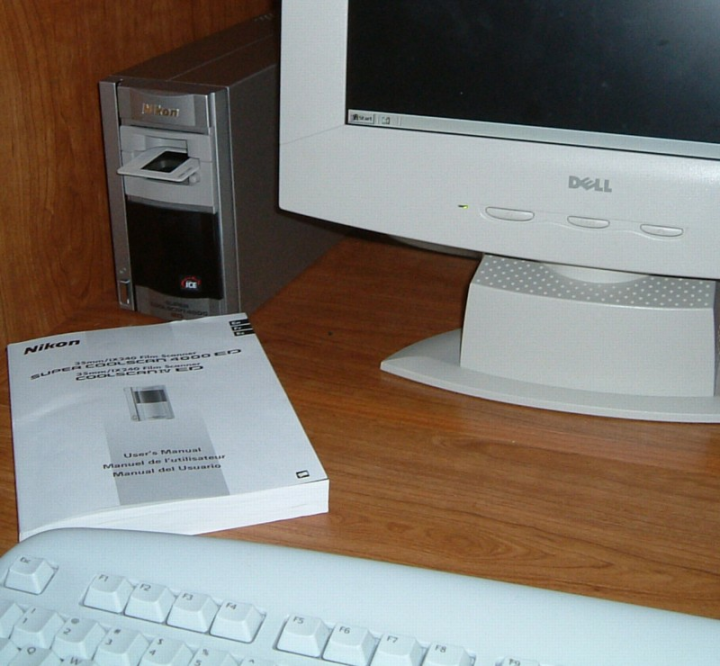
Heavy Pixel Lifting

So, as a (strictly amateur) long-time photo weenie, I have a really fierce legacy problem, and I suspect others must as well, so this is going to be a number-filled digiphotogeek tech-out relieved only by a few (warning: BIG) pretty pictures and at the very end, a technology investment hint.
The legacy is something over ten thousand 35mm slides that I and my Dad took, his dating back to the 1950s.
The older ones - even my older ones - are starting to fade, and they represent the crystallization of memory and are thus beyond price, so they must be saved. Also, while we still have a projector and a screen and a few times a year enjoy looking a slide show, these days most pictures are viewed on computer screens, and that's just fine. So we went out Saturday and invested in a Nikon CoolScan 4000 ED slide scanner, a high-end-amateur grade product of 2001 vintage. It's expensive but it's not very big; in the picture below there's a 35mm slide sticking out of the slot to help get a feel for the size.
It has a Firewire connection, and I was going to plug it into my Powerbook because, well, Macs are for imaging, right? Also the Powerbook comes with Firewire. But it turns out the Nikon comes with a PCI Firewire board, and we have this AMD Athlon1800+ Windows box sitting around used mostly for games, and this is really an industrial kind of application, so it got jammed into the PC as you see above.
<low-comedy>The thing wouldn't work and wouldn't work and we downloaded new software and a new driver from Nikon.com and swore and snarled and then found the piece of packing cardboard still inside the slide carrier. Anyhow.</low-comedy>
You can see why it's expensive. When you launch a scan lots of moving parts whir and grind, and if you peer in the slot you can see the light marching across the film.
The Nikon software that comes with it is kind of klunky and awkward but seems to do the job, and the scratch-and-dust removal module (called "Digital ICE", hmm) seems to work just fine; it also has a well-reviewed module for restoring some of the lost colour in faded slides which we haven't tried yet.
Below are three shots I took in Hong Kong back in 1993, scaled down to a reasonable size, you really don't want to point your browser at what comes out of the scanner.
I'm pretty pleased with the way they come out. But there are serious problems of size and scale and time.
The size problem is due to the fact that this puppy's 4000x4000 scan pumps out a 65 megabyte TIFF file for each slide. Of course, it will happily create a JPEG for you that is a mere 3 meg or so, but dammit this is an archival application, so TIFF would seem the way to go. But we're talking filling a CD up with 10 of them. Suddenly that 120 Gig Firewire drive I bought recently doesn't look very big any more. I sense a DVD-ROM burner in the immediate future.
Then there's the time element.
The way this works is, you stick the slide in, you press
Preview, it grinds away for like 30 seconds and lets you decide
if you want to rotate or crop the or color-correct the slide, then you press
Scan and it grinds away for another 30 seconds or so, and then
you switch to the other window and do a conventional Windows Save
As.
Times ten thousand?
I don't think so.
So there's a 50-slides-at-a-time adapter you can buy for this sucker, and a bit of poking around the software seems to reveal a batch mode. Let's see, 50 of these things is in the range of 3.5-4 Gig, that ought to go on a DVD-ROM, right?
But this is going to require some serious scripting and automation, which is a discouraging prospect on a Windows box. I'd be awful glad to hear from anyone out there that's wrestled this problem to the ground.
The time element bites you in a bunch of ways; cropping these slides and scaling them down to a reasonable size had my poor old 500MHz Powerbook breathing hard.
Oh yes, the investment hint. What with scanners and digicams and videocams and so on, I'm thinking that storage-related peripherals could suddenly be a growth sector over the next few years.